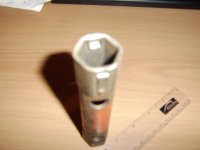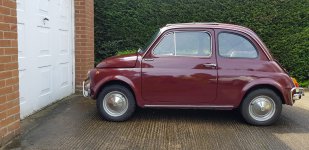Hi Al, you mentioned:
"Turn on the ignition, disengage the choke (if you've been using it), press the accelerator pedal to the floor and hold it there, don't pump it, turn the engine over using the starter lever - there's a very good chance that this will get the engine started (assuming there's nothing else wrong with the engine). Explanation:- holding the accelerator pedal to the floor, stops more fuel being drawn into the flooded engine, allowing the engine to start on the fuel already present in the cylinders."
But I'm confused by this, as when the engine is hot, the procedure is to floor the accelerator, engage starter and job done. I would have thought that flooring the accelerator would add the max amount of fuel / air ?
Confused.com
Rob
Hi Rob,
Thanks for the Confused dot com link, I just got side-tracked and wasted time looking through an insurance comparison website that doesn't even operate in Ireland....
The explanation I gave was primarily for starting a cold engine that has flooded, which is why I said to disengage the choke.
The requirements of a cold engine, fuel-wise, is for a very rich mixture - this is achieved by either restricting the amount of air entering the engine (i.e. by using a choke flap) or increasing the amount of fuel going in (i.e. by using a 'fuel enrichment device' as on the Fiat 500).
The reason a rich mixture is required is because some of the fuel doesn't become atomised properly due to being in contact with cold surfaces on it's way into the engine.
It can actually be quite difficult to ignite petrol unless it can mix with sufficient oxygen (contained in the air). If petrol is atomised on it's way into the engine, the molecules of petrol are surrounded by molecules of oxygen and can be easily ignited.
Starting a hot engine is a little different - a normal air fuel-ratio will suffice, i.e. 14.7:1, by weight not volume. You don't want too much fuel to be drawn into the engine, or it may cause flooding, i.e. a mixture too rich to be ignited, resulting in the spark plugs getting wet with fuel and then being unable to spark.
The problem is when a hot engine is switched off, heat soak can occur, causing the fuel level in the carb float chamber/s to rise (fuel when heated will expand) and run down into the inlet manifold/tracts - so there is likely to already be some fuel on it's way into the engine, you don't want to add more. Some inlet manifolds have a drain tube with a small orifice to try to drain this fuel away.
By opening the throttle (pressing the accelerator to the floor) you 'kill' the depression in the carb, preventing fuel being sucked out of any of the fuel orifices (idle, progression or main jet circuit),
while the engine is being spun over at normal starter motor speed..
Opening the throttle, on a carb. fitted with an 'accelerator pump jet circuit' will squirt a measured amount of fuel into the carb and this will be drawn into the engine - this fuel will be easily vaporised due to the heat of the engine. This, plus any that has gone in due to heat soak, will be sufficient to start the engine.
Of course, if you 'pump the accelerator pedal', you will be injecting more fuel with each pump of the pedal - this may result in flooding of the engine.
Your thinking that flooring the accelerator would add the max. amount of fuel/air?
When the accelerator is pressed to the floor (throttle fully opened), air can still be drawn in. The rate at which the air can speed up depends on the sucking power of the engine, this is not great at starter motor speeds (maybe 300rpm?). But, for fuel to be drawn from the holes/jets, there has to a depression (vacuum) across those holes/jets. Low air speed = low or no depression. No depression = no fuel flow. Holding the throttle fully open , virtually kills any depression across the fuel holes/main jet orifice, stopping fuel flow. But when the engine starts, the speed of the air going in increases, the depression across the fuel holes increases, resulting in fuel now being drawn in. Now, if you open the throttle fully, max air and FUEL can be drawn into the engine.
Also bear in mind, that fuel has more inertia than air, so takes more time to speed up - this is why an accelerator pump jet circuit is fitted to most carbs
(some Fiat 500 model carbs don't have any), to provide temporary fuel enrichment on engine acceleration, so that the engine doesn't bog-down when the throttle is suddenly opened (air flow increases immediately, fuel flow lags behind).
Most of the above problems were eradicated by the arrival of fuel injection, no carb to flood, fuel injected directly into the airstream (or indeed the cylinders), so no lag, no flat-spots etc.
Hth,
Al.





